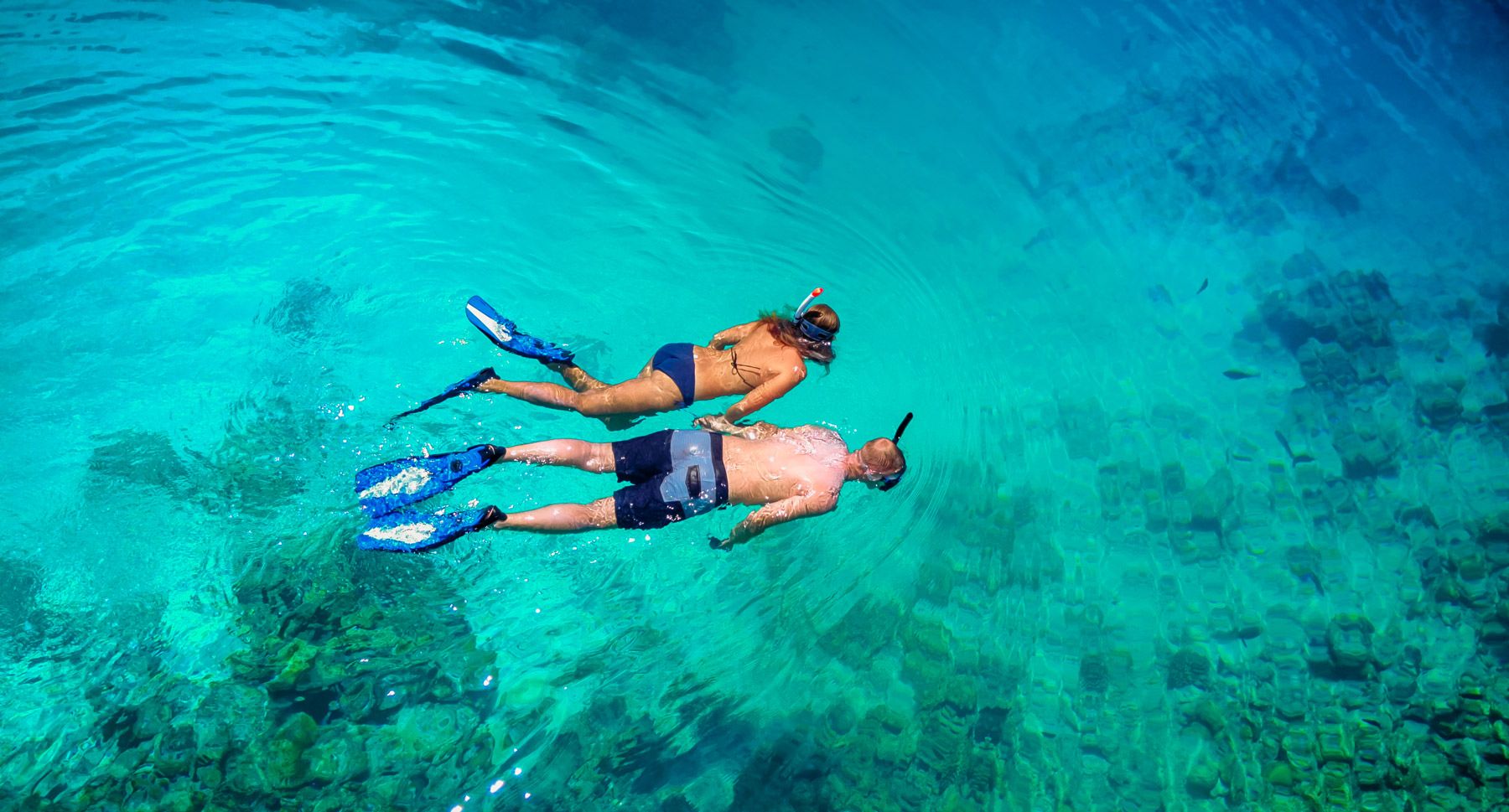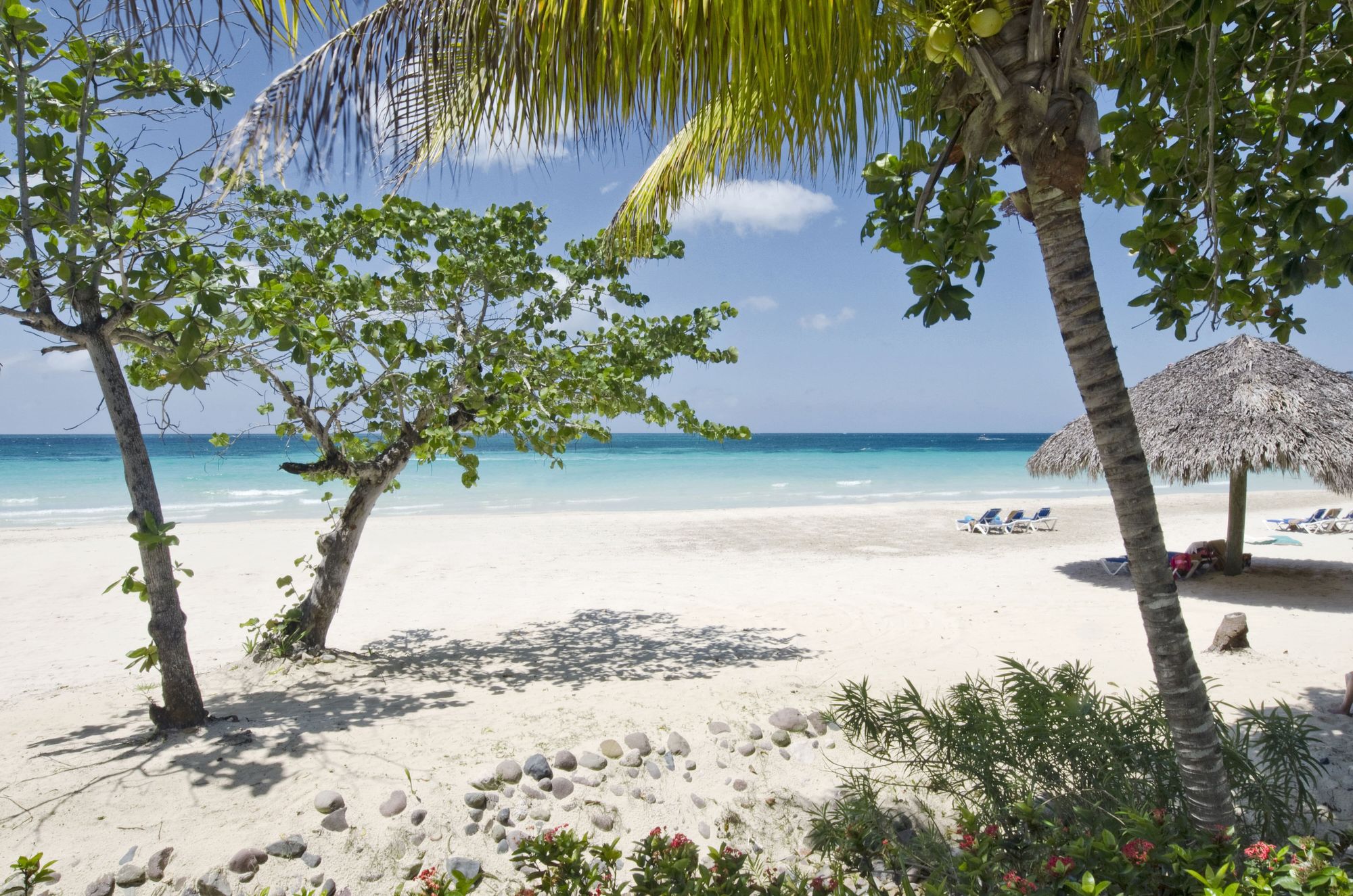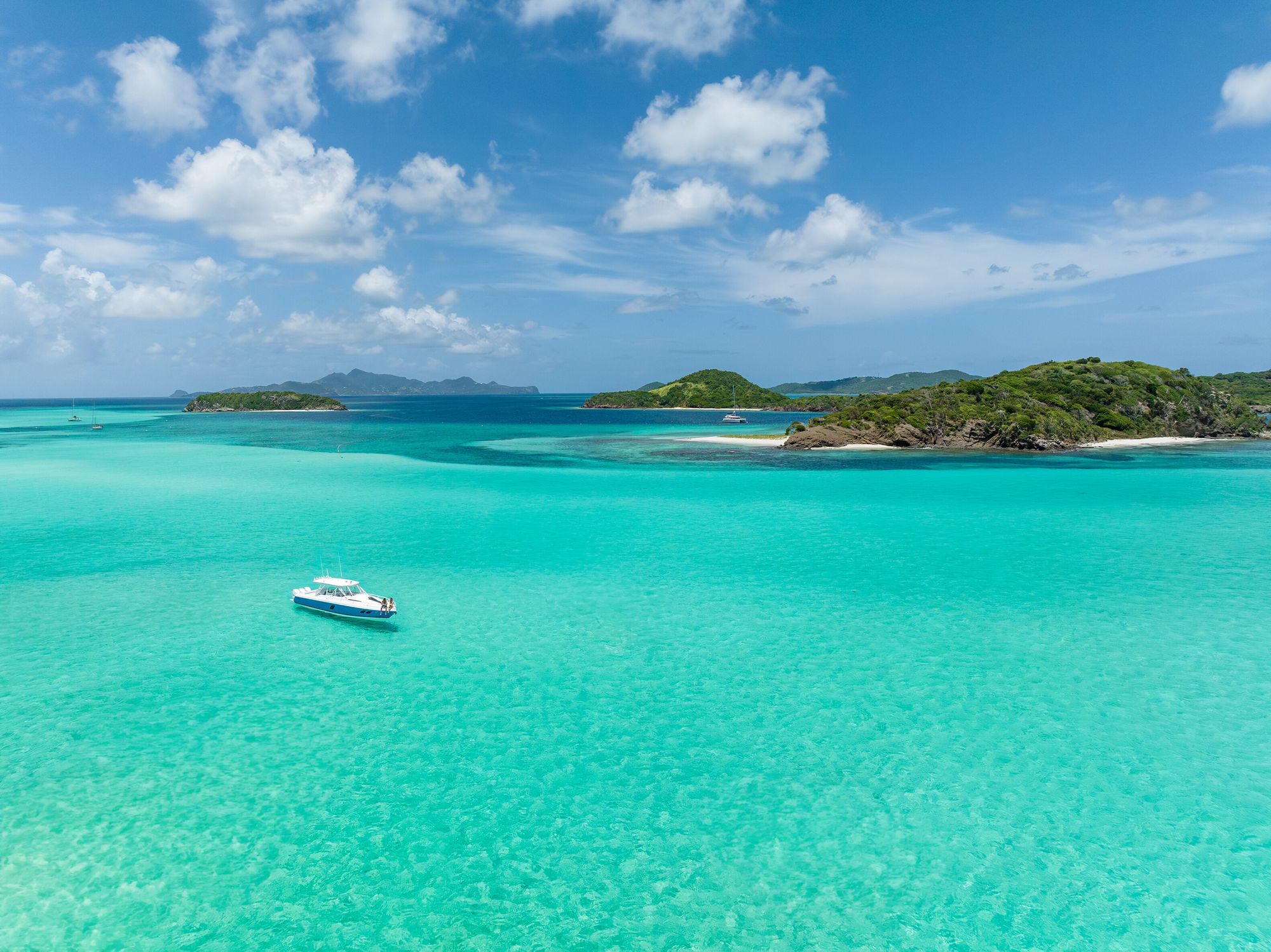All You Need To Know About The Grenada Underwater Sculpture Park
“The ocean is the most incredible exhibition space an artist could ever wish for”. Words from famous underwater sculptor Jason deCaires Taylor. The creator has sculptures all over the world, but as far as his addition to the already beautiful waters of Grenada, you can be assured that nowhere else in the Caribbean will you find an underwater attraction that is as unique. The Grenada Underwater Sculpture Park as it is known, is home to several of the sculptor’s creations, and is the world’s first underwater sculpture park. It is located off the West Coast of Grenada.
Grenada is on its own a spectacular place to visit, what with its spicy nature, rugged and remarkable terrain, and vibrant people. The opportunity to be able to travel to the island for more than just sunny shores and beautiful stretches of beach is something that should not be overlooked, which is something the thousands of people who have already travelled to see the underwater sculpture park in the island’s waters have already found out.
You can see the park via a snorkeling or scuba diving trip, though lots of people recommend scuba diving as the most ideal way to take in the structures as you can stay underwater longer, explore, and take as many photos as you want. The sculptures are about 3-5 meters underwater, with some being just six feet below the surface.
The Grenada Underwater Sculpture Park
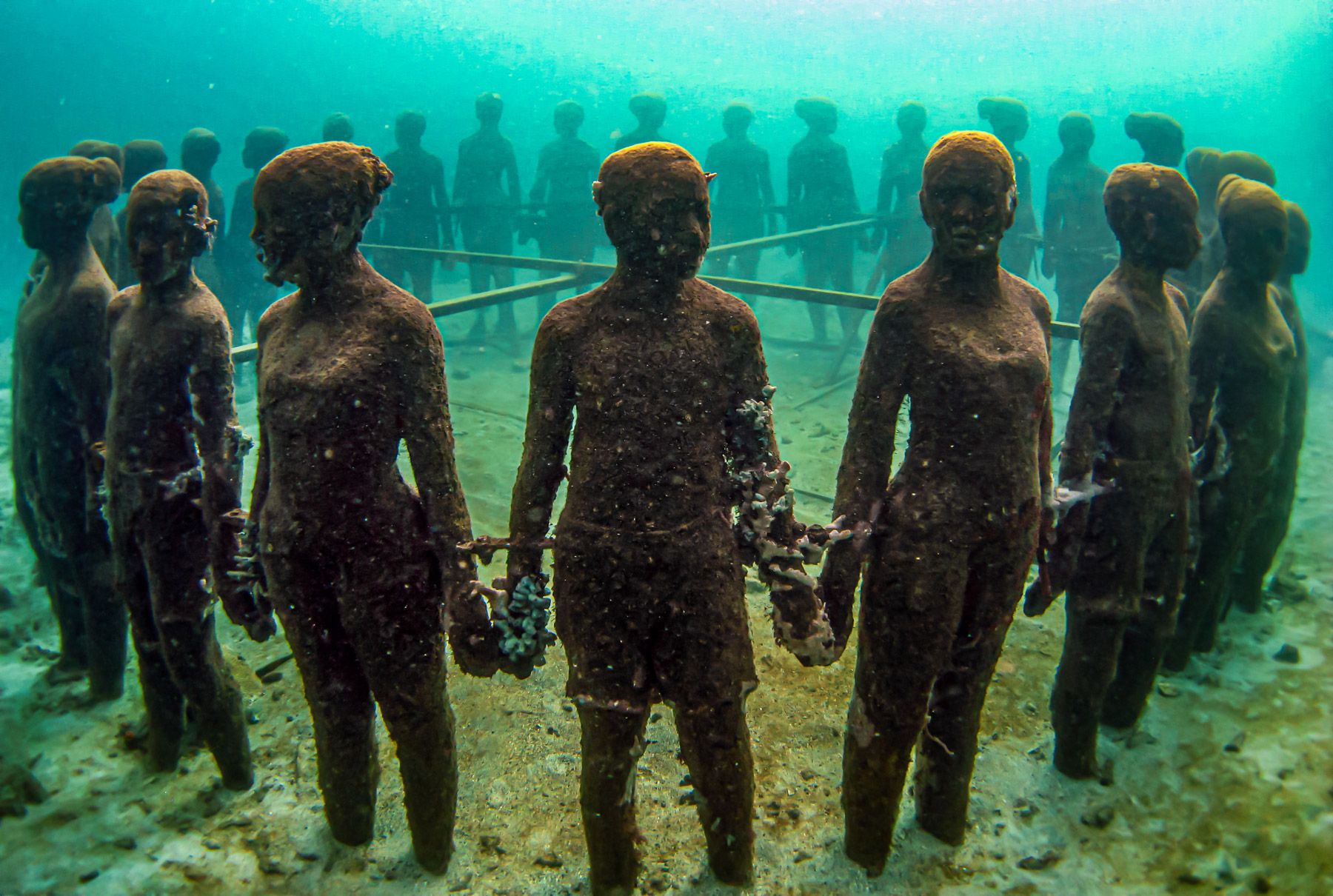
The sculptures found in Grenada’s underwater park have become one with the space in such a profound way that upon diving to see them firsthand, you may be led to believe, based on what you see and the atmosphere, that art has existed since ancient times. Not so, as the park was first constructed in 2006. Constructed from concrete and steel, some of the sculptures weigh as much as 15 tons. They’re held in place by bolts, on the bottom of the seafloor. The sculptures, 75 in all, lure divers of all sorts and even glass bottom boat tours, which also get decent views due to the fact that some of the sculptures are relatively close to the surface.
Thus far, Grenada’s Underwater Sculpture Park has stood the test of time; though you’ll notice that some did not escape completely unscathed. It’s just as well though, as the essence of the sculptures remain, and the national park continues to support conservation efforts as some of the entrance fees are used to aid marine management initiatives.
Highlights of the Grenada Underwater Sculpture Park
There are quite a few sculptures just waiting to be explored at the underwater sculpture park. The intention of the British sculptor who created it was not just to put together something that would look good underwater but would also aid conservation efforts. Reef damage had already been done, and the statues were put in after to help protect the reefs, help maintain the health of the ecosystem, and eventually, help restore underwater life in that area.
Christ of the Deep
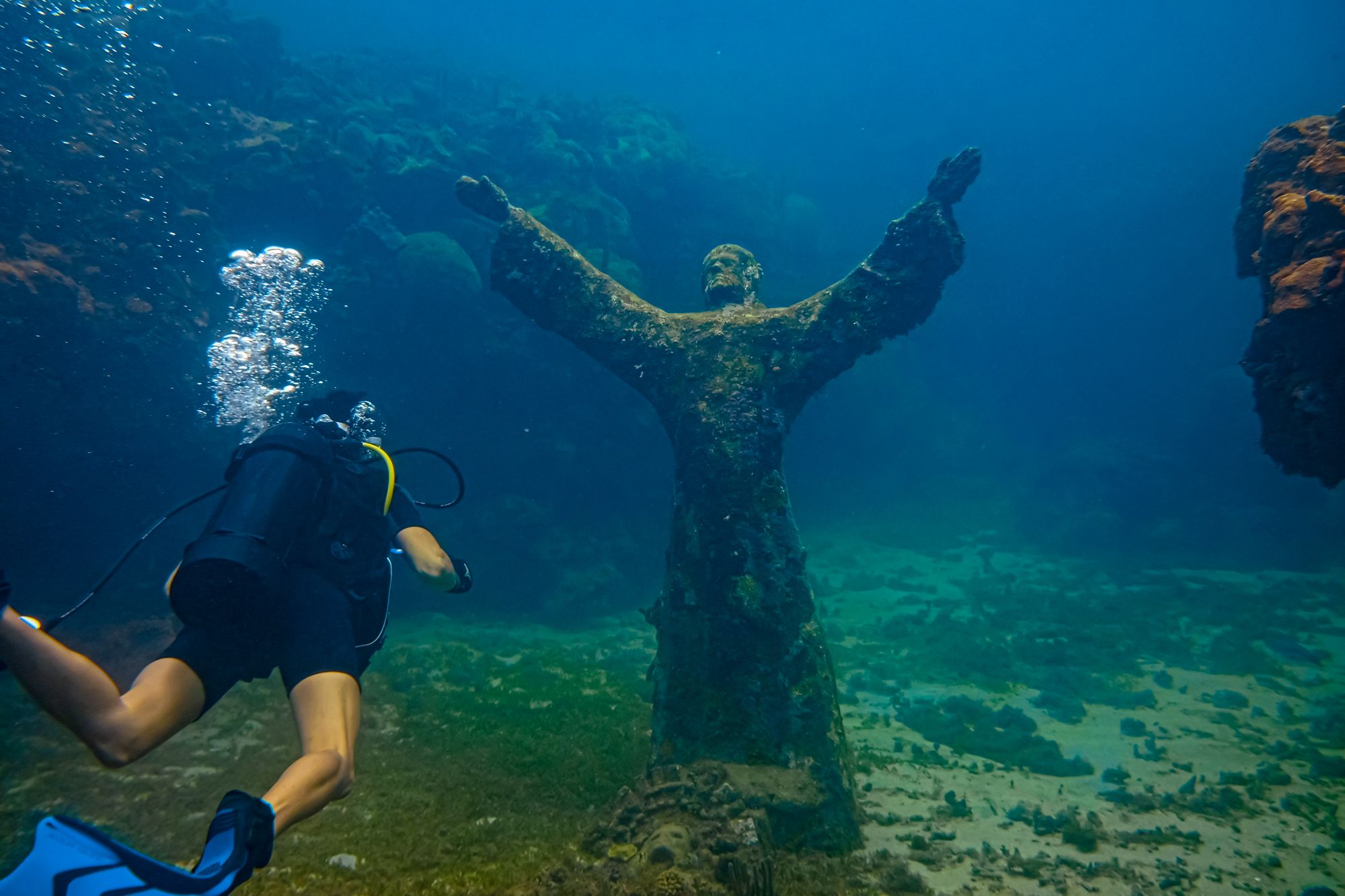
This is one of the highlights of the Grenada Underwater Sculpture Park. Christ of the Deep was created by Troy Lewis. Its installation was supported with funds from the Grenada Tourism Authority. This sculpture happens to be a replica of the original sculpture sited on the waterfront of the Carenage, St. George's harbour, which was given in gratitude to the people of Grenada for their hospitality and selflessness when they aided 600 passengers and crew members of the Bianca C. At its installation, the underwater sculpture marked the 50th anniversary of the Bianca C sinking. This wreck, the largest in the Caribbean, is also a popular scuba diving site.
The Vicissitudes
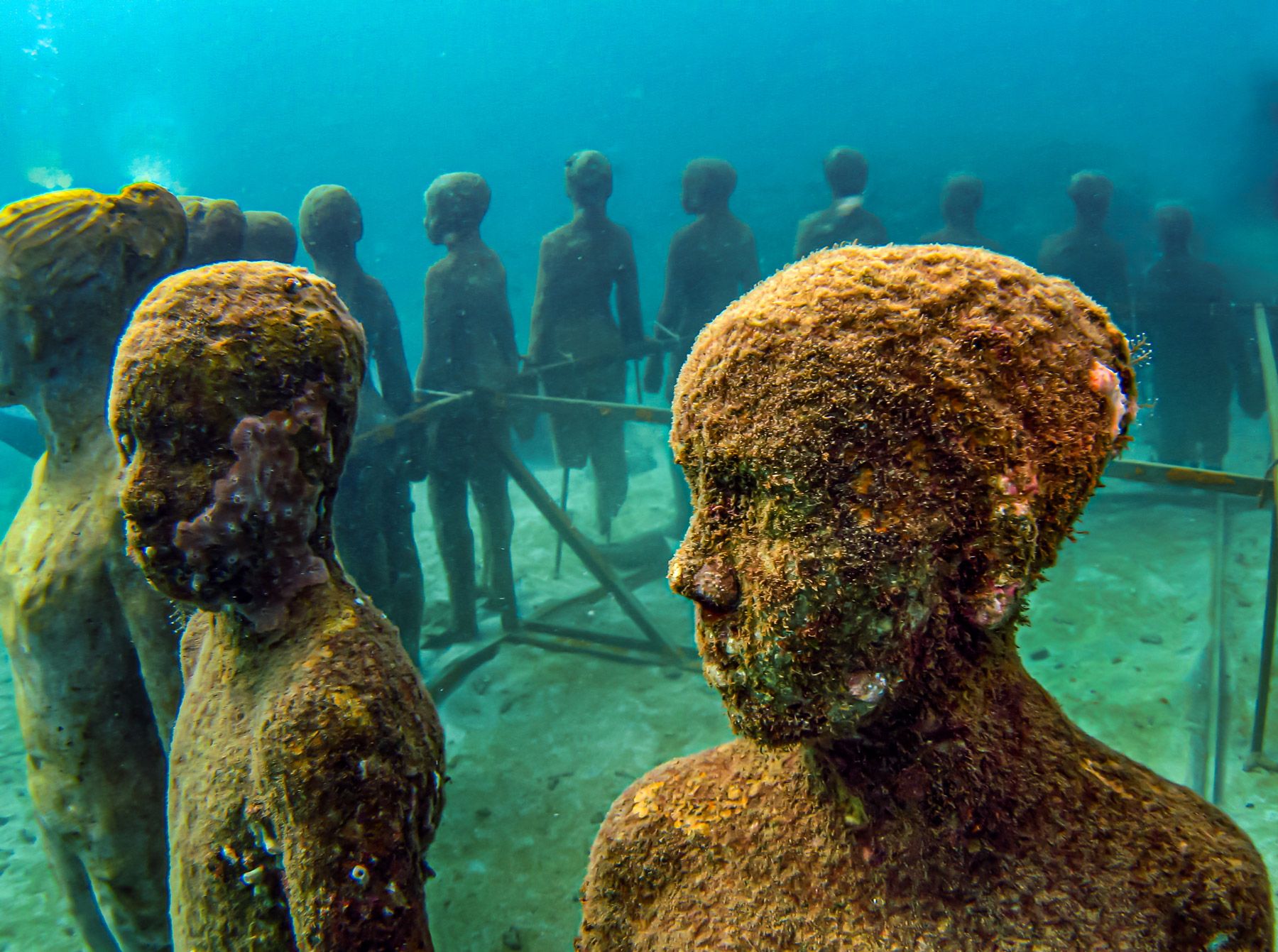
Truly iconic, this sculpture features a group of children, 26 in all, Grenadian, and holding hands. They are positioned in a circle, and there are varying interpretations for this work of art. Some say it represents the circle of life, while others say that the children represent slaves thrown off ships so many years ago. There is a trend of thought that suggests it may even relate to the lives of these slaves being cut off, but largely, the true meaning remains a mystery. The creator, Jason deCaires Taylor’s true intent moves in and out with the waves. Still another analogy suggests that the concrete sculpture depicts “the adaptability of children in any environment as the sea embraces them and the children become part of their new environment”. Whatever was the intention of its creator, the Vicissitudes is a truly historic piece, and it is certainly a sight to behold on an underwater dive.
The Lost Correspondent
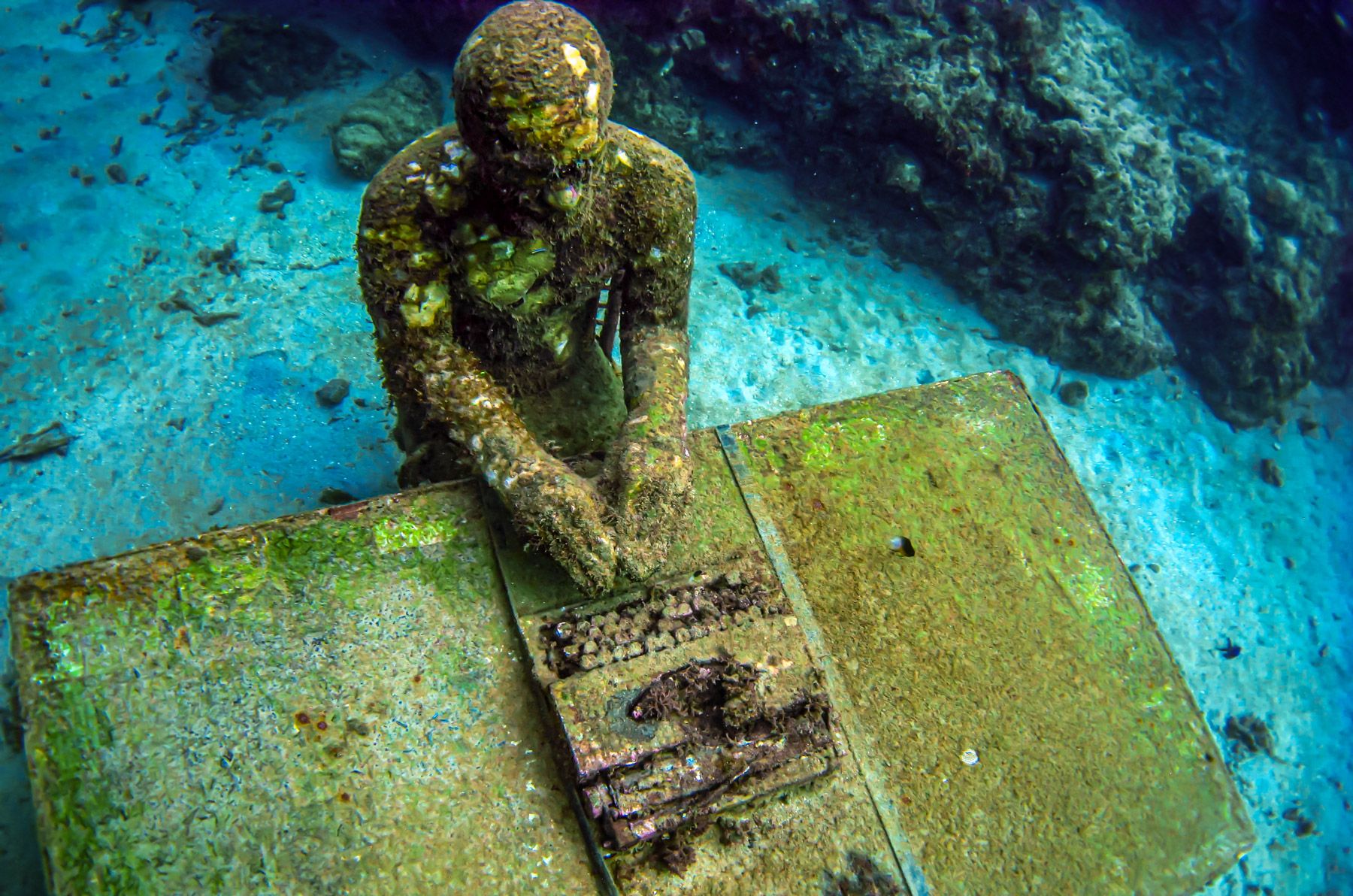
Among the 65 cement pieces, you’ll likely come across the Lost Correspondent, who’s also referred to by some as ‘the newspaper man’ in your explorations on the bottom of Molinere Bay. It was submerged by its creator off the coast of Grenada. According to Taylor, that was the one sculpture that took the park from one, to 26 historic pieces.
Who created the underwater sculptures?
British artist, photographer, sculptor and environmentalist Jason deCaires Taylor created most of the sculptures in the sculpture park which was opened in 2006. Construction of the underwater sight was managed by The Grenada Underwater Sculpture Management Inc., a non-profit organization. They, along with the local government, are responsible for developing and maintaining the park.
The building process
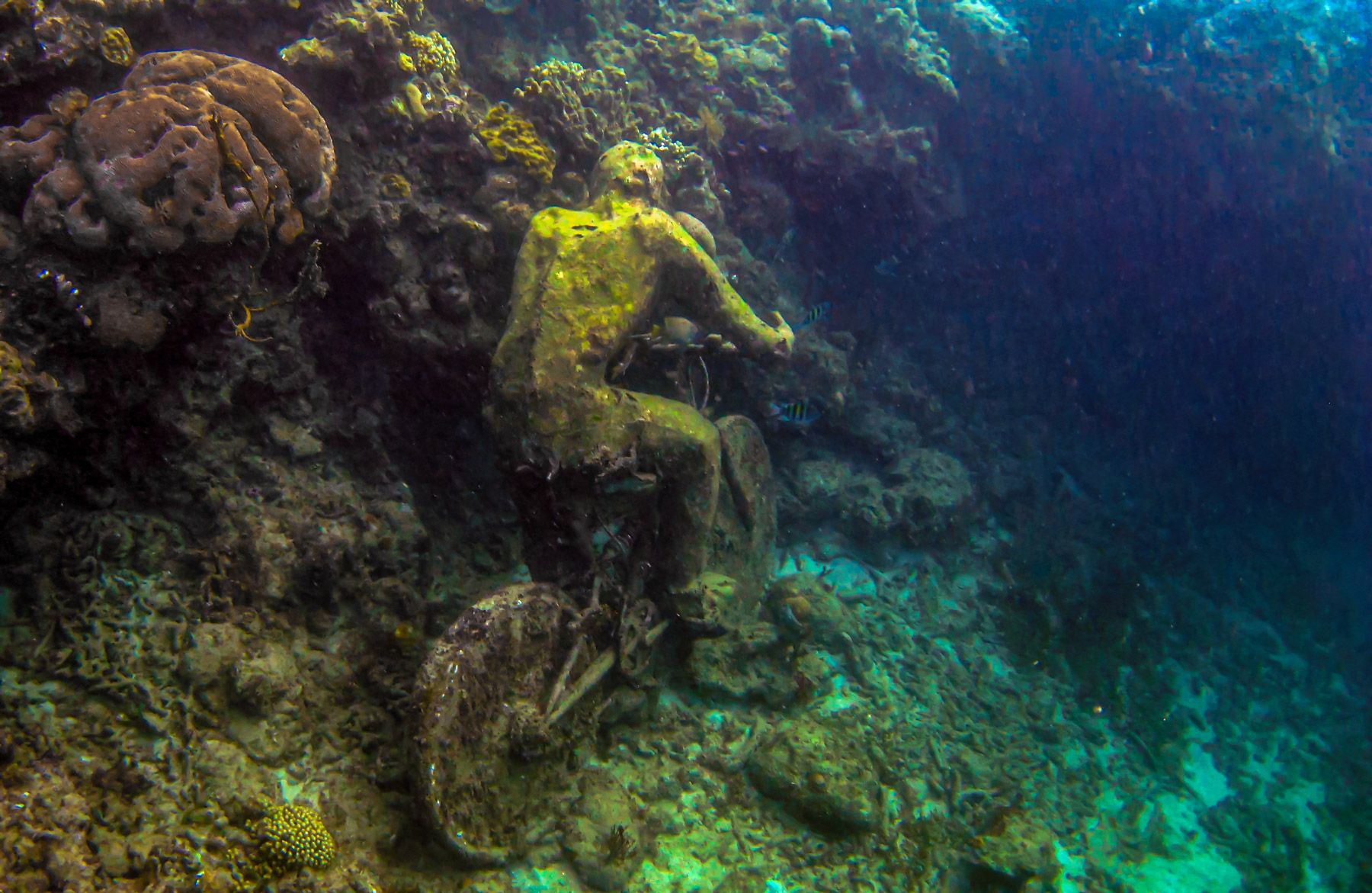
In a 2015 TED Talk, sculptor Jason deCaires Taylor explained that the sculptures were all created with materials and designs that help encourage life. That included a long-lasting pH-neutral cement which “provides a stable and permanent platform; it is textured to allow coral polyps to attach. We position them down current from natural reefs so that after spawning, there are areas for them to settle. The formations are all configured so that they aggregate fish on a really large scale,” according to the creator. The sculptures are all constructed on land, and then transferred into the ocean by crane.
The full TED Talk is available here: Underwater Museum Ted Talk
To detail further the interaction between the sculptures and marine life, an excerpt from the TED Talk elaborates: “Sponges look like veins across the faces. Staghorn coral morphs the form. Fireworms scrawl white lines as they feed. Tunicates explode from the faces. Sea urchins crawl across the bodies feeding at night. Coralline algae apply a kind of purple paint. The deepest red I’ve ever seen in my life lives underwater. Gorgonian fans oscillate with the waves. Purple sponges breathe water like air. And grey angelfish glide silently overhead.”
Some have described the experience of exploring the underwater sculpture park as both “spectacular and haunting”, others as “near-psychedelic” with all the colors and other changes that have been incorporated as life progresses underwater.
How do I get to the Underwater Sculpture Park?
It’s not difficult to find the Underwater Sculpture Park once in Grenada. It is located off the coast of Moliniere Point. You can get there either by taxi, bus, or private car. Some people even take the 45-minute walk to the area from St. George’s. If you’re trying to cut costs, buses are a good option, but if you’d like to get there quickly without the hassle of waiting for a bus to go there and once you’re ready to leave, a cab or a rental is the better option. Driving from Grand Anse takes under 30 minutes, while you can get there from St. George’s in about 10 minutes. Entry to the marine protected area is free, but you may need to pay a small fee to dive.
You can either opt for a glass bottom boat and see the sights from above or get on a snorkel or scuba diving trip. From the glass bottom boat, you won’t be able to see all statues, just the ones that are close to the surface. The same accounts for when you go on a snorkeling trip. Get to see more of the sculptures by going on a scuba diving trip. It will be worth your time!
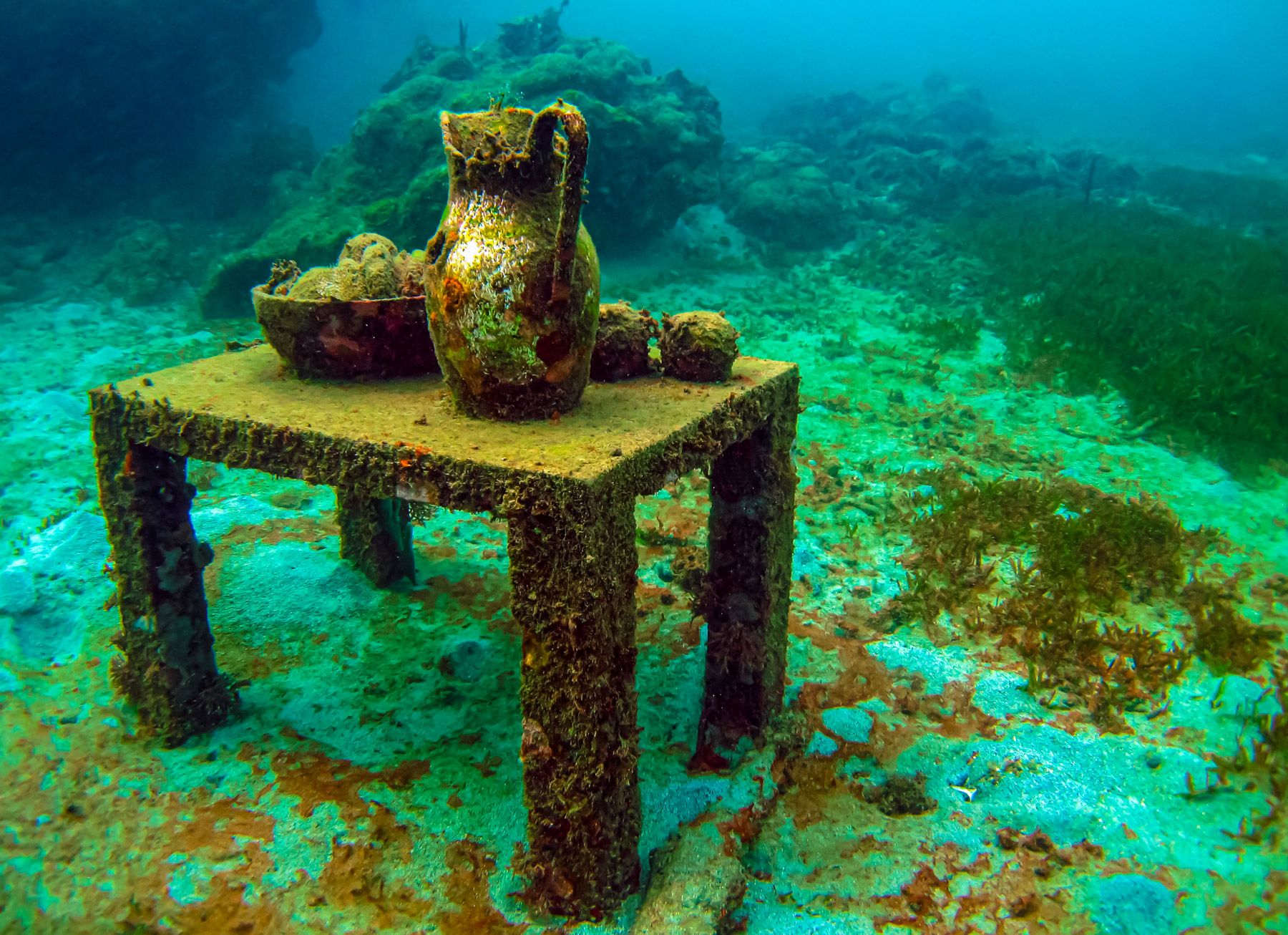
Expert tip: Want to scuba dive the Underwater Sculpture Park and other spectacular sites? Guests of the Sandals Grenada all-inclusive resort dive for free, as often as they want! This includes top-of-the-line equipment. At additional costs, you can also get PADI certified at the resort.
Not a diver? Island Routes offers two amazing snorkeling tours to the underwater Sculpture Park; the first is a Power Boat Adventure Snorkel Tour that includes a visit to the sculpture park, while the other is a Seafood Snorkel Cruise that also includes a visit to the sculpture park. The Power Boat Adventure costs $112 per person, and the Seafood Snorkel Cruise costs $199 per person. On the Seafood Snorkel Cruise, you’ll sail on a 60 ft., motorized catamaran, first to Hog Island where you’ll be greeted on arrival with champagne, before digging into a grilled lobster lunch (seasonal), and later swimming and exploring the island. Described as the ride of your life, you’ll ride on a powerful twin-engine boat for the Power Boat Adventure, which includes sightseeing and an informative tour.
Tip: Bring along a towel, swimsuit, cash, a camera, and insect repellant. Leave your jewelry at home to make sure you don’t lose any valuables while getting in the water!
Are there any rules when visiting the Grenada underwater sculpture park?
You’ll need to purchase a wristband before venturing into the Grenada Underwater Sculpture Park; it costs about US$1-2. After you purchase the wristband, you’ll need to keep it on your wrist for the duration of the excursion. If you’re diving with a tour group, the fee might already be included. If you’re planning on diving from a yacht, you may need to get a permit. While setting up your dive, make sure that it’s with a credible dive operator (like Sandals), and if they make the payment on your behalf, ask about your wristband. Proceeds will be used to maintain the park. The safety and preservation of natural and manmade structures in the Underwater Sculpture Park are a top priority, which is why visitors should always tie their boats to the mooring provided, and do not drop anchor.
Grenada: the place to be for snorkeling and scuba diving!
Grenada is an amazing island when it comes to snorkeling and scuba diving opportunities. Morne Rouge Bay is known to be one of the most popular snorkeling sites close to the mainland. You will find the beach south of Grand Anse beach, which is usually the more crowded option. Other popular snorkel spots include Levera National Park, Moliniere Bay and La Sagesse.
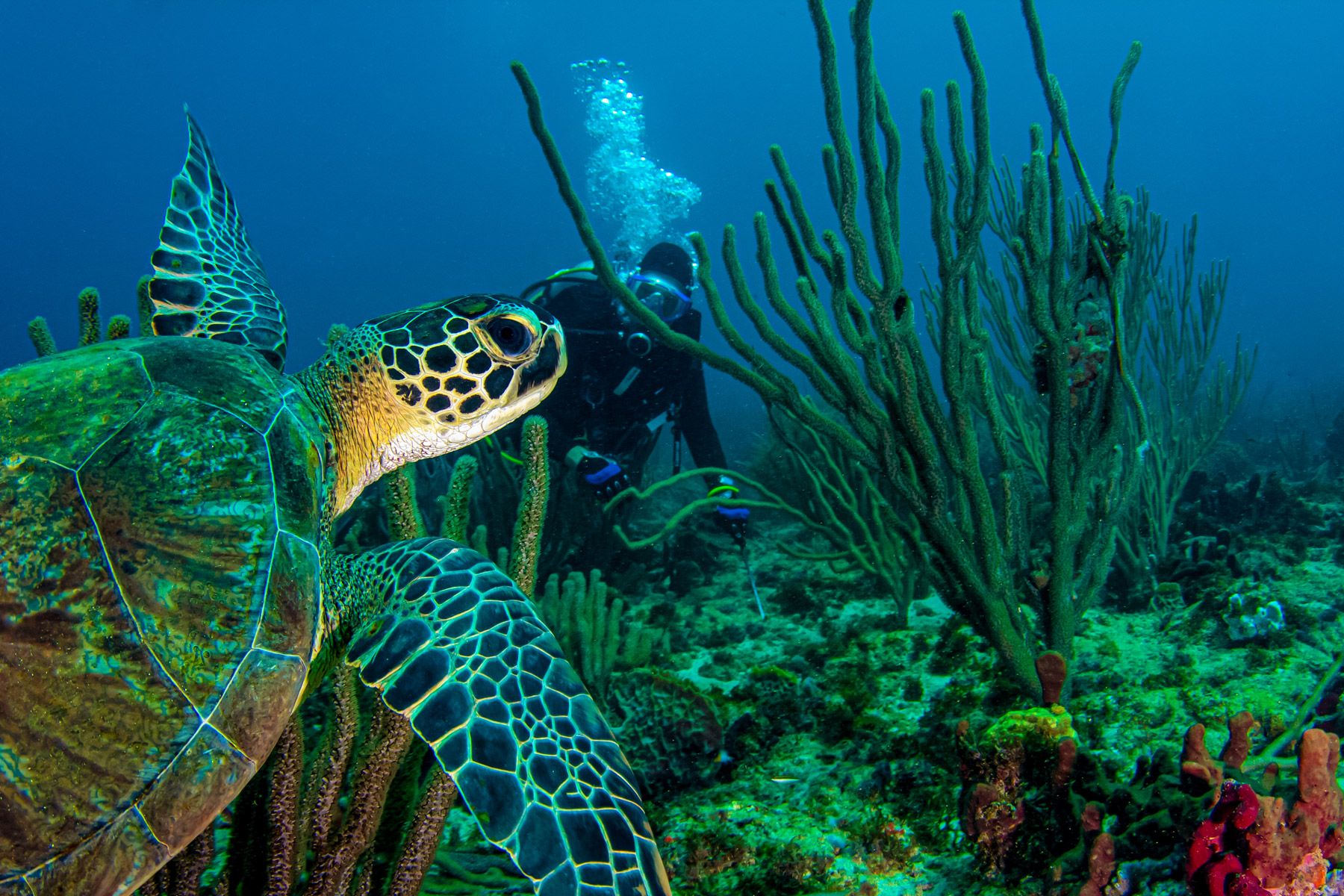
Advanced PADI scuba divers will love the Bianca C shipwreck, a 600-foot long passenger ship. Other popular shipwrecks include the Hema wreck, Shakeem wreck, King Mitch and the Veronica. Besides the Underwater Sculpture Park, popular reef dive sites include Fisherman’s Paradise, Purple Rain, Sister Rocks, Mabouya Wirlpool and Twin Sisters.
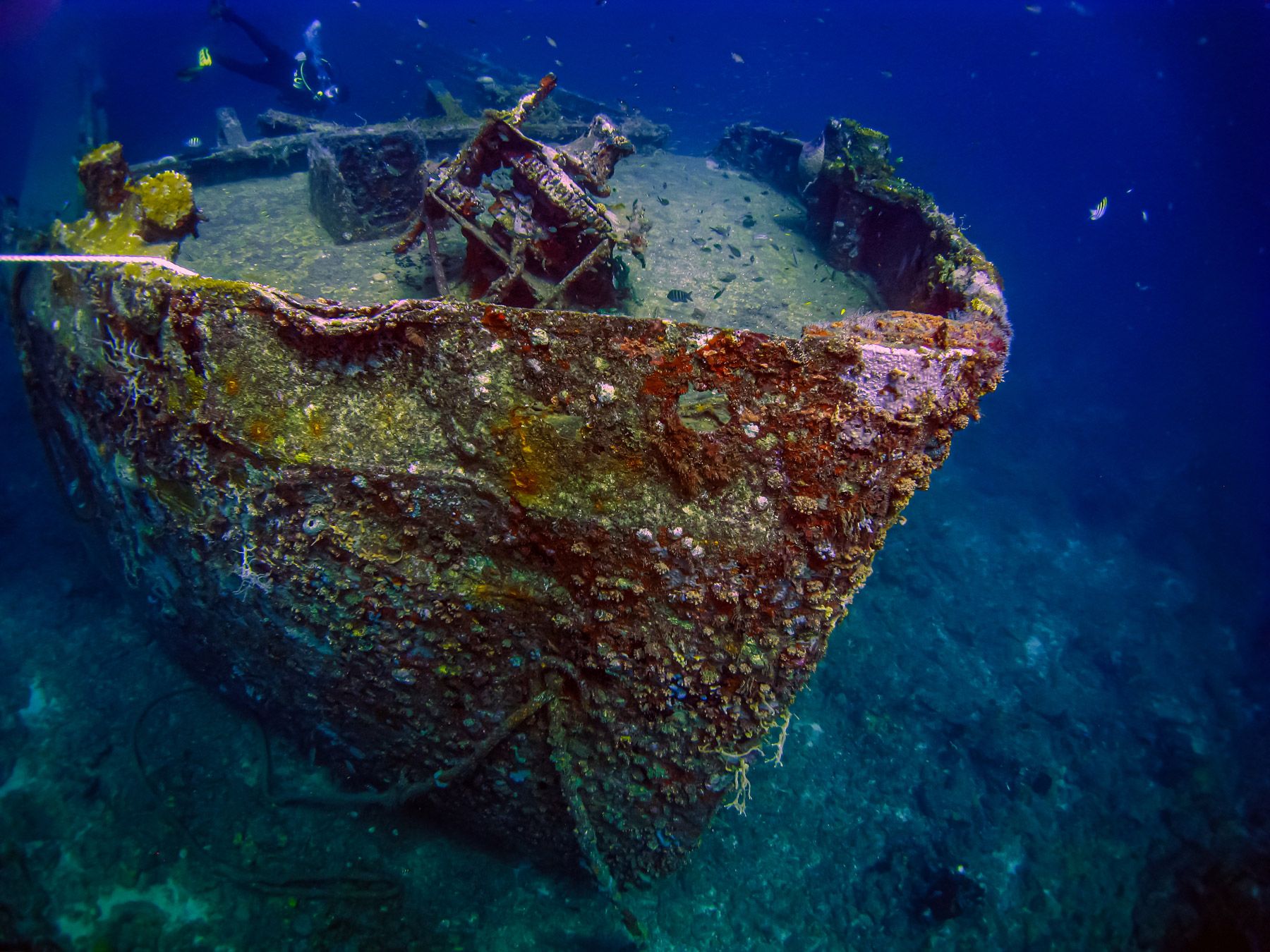
Visit the Sculpture Park to support conservation efforts
The Grenada Underwater Sculpture Park was instrumental in the island’s government designating the area a marine protected site. It was once listed by National Geographic as a wonder of the world. The overall message from the sculptor who created it is that we don’t regard our oceans as sacred, when we should. Perhaps a visit to the Grenada Underwater Sculpture Park is what you need to get back in tune with nature, explore something truly incomparable, and make a mark on conservation and marine protection efforts worldwide.
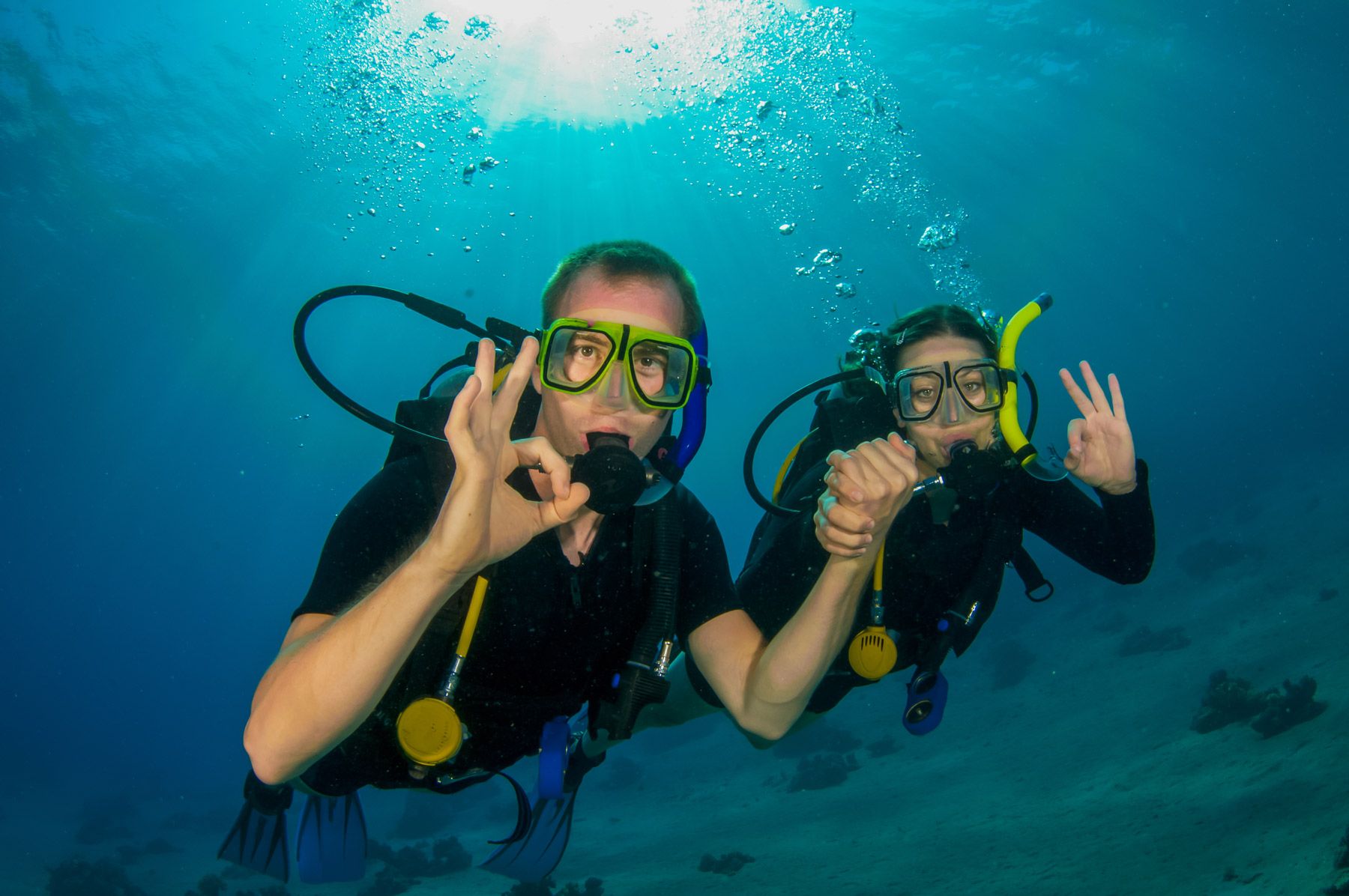
Traveling to Grenada and not sure where to stay? Sandals Grenada is a great all-inclusive option which includes free scuba diving trips for all guests. From this resort you’ll have easy access to explore the Underwater Sculpture Park, and other amazing sites on the island.
Bonus: Other sculptures created by Jason deCaires Taylor
In 2009, Taylor moved to Mexico, where he started by casting local fishermen. These works grew to small community, then to a population of people in defense of the sea. They were all transitioned to an underwater museum now with over 500 sculptures. The designs were scaled up after that, and now the sculptor is credited for having created the largest underwater sculpture in the world, in The Bahamas. His creation, Ocean Atlas, stands at 18-feet tall, weighing 60 tons. It depicts a Bahamian girl, who appears to be carrying the weight of the ocean on her shoulders, much akin to the Greek myth of Atlas.
The sculptor has, in addition to sculptures at the Grenada Underwater Sculpture Park, also created sculptures that are now off the coast of Lanzarote, Spain. The sculptures in that area are the first of their kind in the Atlantic Ocean and they are known as the Museo Atlantico. Their intent is to remind people of the importance of taking care of the ocean. He also has many other sculptures in other areas on the globe.
